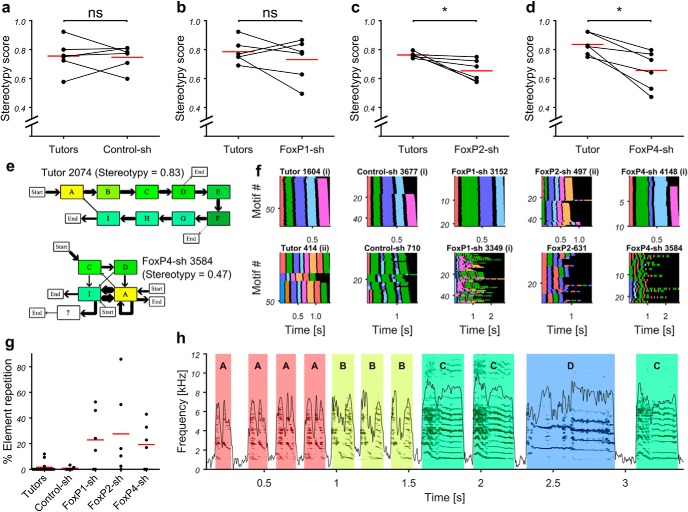Figure 12.
After FoxP2 and FoxP4 kd, the sequential delivery of song elements was more variable in pupils than in their tutors. In addition, some FoxP1-sh, FoxP2-sh, and FoxP4-sh have a high rate of song element repetitions (stuttering) not found in tutors and control animals. a–d, Paired scatter dot plot. Each dot represents the stereotypy score for 1 animal. Red line indicates the mean. Tutor-pupil pairs are connected by black lines (Wilcoxon matched pairs signed rank test, FoxP2-sh and FoxP4-sh exact rank, p = 0.0313, n = 6, W = 21). e, Sequence diagrams of the songs of FoxP4 kd bird 3584 (bottom) and its tutor 2074 (top). Boxes with letters A to I represent song elements. A song element not found in the tutor song is marked by a question mark. Arrows indicate transitions between subsequent song elements. The size of an arrow is proportional to the relative frequency of occurrence. Arrows that do not originate at a song element mark the start of a song. Arrows that do not point to an element mark the end of a song (e.g., all songs of 2074 start with A and end mostly with I, rarely with D or F). f, Representative examples of sequence variability in 20–50 sequentially sung motifs (y axis), indicated as thin color-coded lines, sorted, and stacked. The duration of each song elements is indicated by one color, song elements of the same type have the same color, and silent gaps are shown in black (x axis). Motifs are sorted alphabetically by element sequence and within identical sequences by motif duration. We show 1 bird with high (top row) and one with low sequence stereotypy (bottom row) from each experimental group (left to right: tutors, Control-sh, FoxP1-sh, FoxP2-sh, FoxP4-sh). Pupils that were tutored by one of the tutors shown in the first column are indicated by (i) and (ii). g, Quantitative representation of stuttering. Each dot represents the percentage of all song elements of 1 animal that are part of a stuttering bout (i.e., a string of two or more successive elements of the same type). h, Qualitative representation of stuttering. Sonogram of an example song of FoxP2 kd bird 628, showing an element repetition rate of 81.8% (9 of 11 elements are part of a stuttering bout). *p < 0.05; ns (not significant) p > 0.05.

